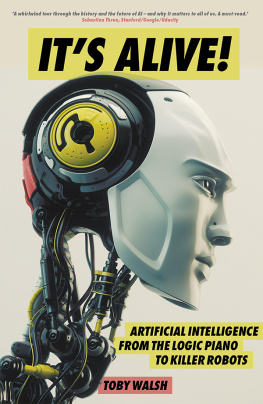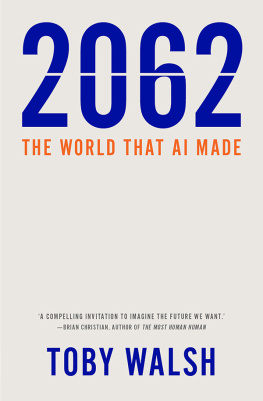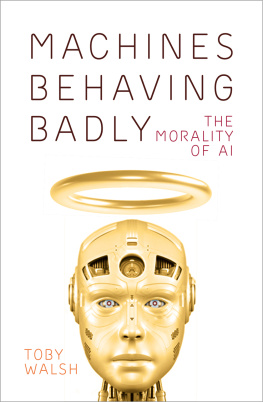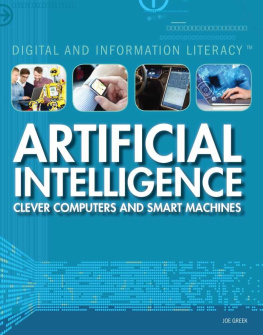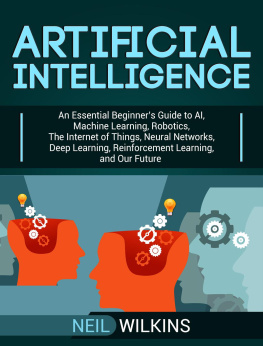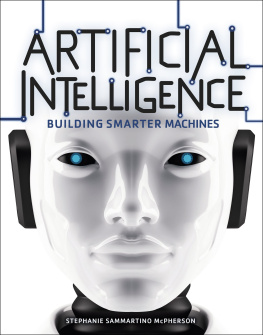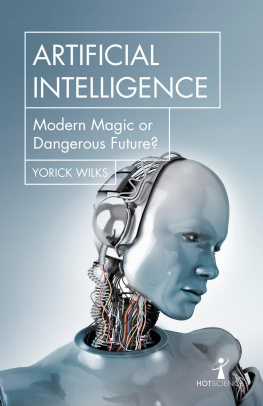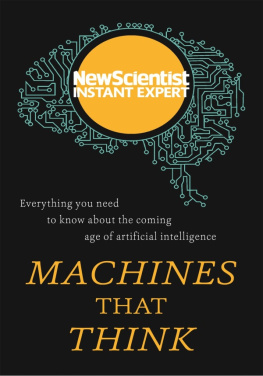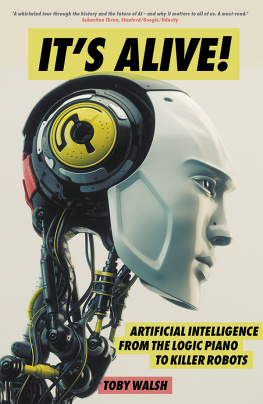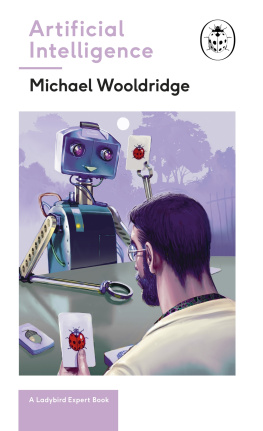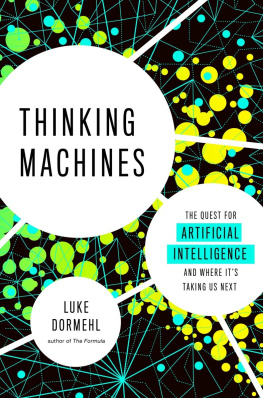TOBY WALSH has spent his life dreaming and researching about machines that might think in universities around the world. He was named by the Australian newspaper as one of the hundred rock stars of Australias digital revolution. He is a Professor of Artificial Intelligence at UNSW and at Data61, Australias Centre of Excellence for ICT Research. He has been elected a Fellow of the Australian Academy of Science and of the Association for the Advancement of Artificial Intelligence. He has also won a number of prizes, including the Humboldt Research Award. He has held research positions in Australia, England, France, Germany, Ireland, Italy, Scotland and Sweden.
He regularly appears on TV and radio talking about the impact of AI and robotics. He also writes frequently for print and online media such as New Scientist, American Scientist and Cosmos. His Twitter account, @TobyWalsh, has been voted one of the top ten to follow to keep abreast of developments in AI. He has given talks in venues like CeBIT, TEDx and the World Knowledge Forum, Asias answer to Davos. He has spoken at the United Nations and elsewhere about the need to ban lethal autonomous weapons (aka killer robots). You can read more at his blog, http://thefutureofai.blogspot.com.
PRAISE FOR ITS ALIVE!
A whirlwind tour through the history and the future of AI and why it matters to all of us. A must-read.
Sebastian Thrun, Stanford/Google/Udacity
Toby Walshs story of how Artificial Intelligence evolved from the dreams of Alan Turing to a powerful technological force today is exciting, insightful and incisive. Will his predictions about how AI will change life as we know it in the coming decades prove equally dead-on? I, for one, would not bet against him!
Henry Kautz, Past President of the Association for the Advancement of Artificial Intelligence, Founding Director of the Institute for Data Science, and Professor at the University of Rochester
A comprehensive overview that avoids the hype and explains what AI can actually do, written by an expert practitioner of the field.
Peter Norvig, Director of Research at Google, and co-author of Artificial Intelligence: A Modern Approach
Youve heard the hype, now read about the reality from one of the leading researchers in the field of Artificial Intelligence (AI). In his elegant prose, Prof. Toby Walsh describes the past, present, and future of AI culminating in ten tantalizing predictions for the impact of AI on medicine, transportation, entertainment, and more by 2050.
Oren Etzioni, CEO of the Allen Institute for Artificial Intelligence

Published by La Trobe University Press in conjunction with Black Inc.
Level 1, 221 Drummond Street
Carlton VIC 3053, Australia
www.blackincbooks.com
www.latrobeuniversitypress.com.au
Copyright Toby Walsh 2017
Toby Walsh asserts his right to be known as the author of this work.
ALL RIGHTS RESERVED.
No part of this publication may be reproduced, stored in a retrieval system, or transmitted in any form by any means electronic, mechanical, photocopying, recording or otherwise without the prior consent of the publishers.
National Library of Australia Cataloguing-in-Publication entry:
Walsh, Toby, author.
Its alive!: artificial intelligence from the logic piano to killer robots / Toby Walsh.
9781863959438 (paperback)
9781925435689 (ebook)
Artificial intelligence.
Artificial intelligenceForecasting.
Computational intelligence.
Cover and internal design by Peter Long
Cover photograph by Ociacia / Shutterstock
To A and B
who make my life so interesting
PROLOGUE
I begin with a quotation from 1950. The world was a much simpler place back then. Television was in black and white. Jet planes were still to enter passenger service. The silicon transistor was yet to be invented. And there were fewer than a dozen computers in existence worldwide. Each was a glorious combination of vacuum tubes, relays, plug boards and capacitors that filled a room.
It therefore took a bold person to predict: I believe that at the end of the [twentieth] century the use of words and general educated opinion will have altered so much that one will be able to speak of machines thinking without expecting to be contradicted. What an idea! Thinking machines. Will machines really be able to think in the near future? And if they can, how long before they are better at it than us?
But first who made this bold prediction? Should their prediction carry much weight? Well, the person who made it was ranked by Time magazine in 1999 as one of the 100 Most He was, without a doubt, one of the centurys more enigmatic thinkers. A mathematician. A wartime hero. Above all, a dreamer. And his dreams continue to influence us today, long past his early death.
An Oscar-winning movie has told the story of how pivotal he was in the breaking of the Germans Enigma code during World War II. Winston Churchill described how he and his fellow code-breakers were the geese that laid the golden egg but never cackled. By the reckoning of most historians, breaking Enigma shortened the war by at least two years. And that undoubtedly saved millions of lives. But come the end of the twenty-first century, I doubt that code-breaking is what the author of our quotation will be most remembered for.
En route to breaking Enigma, he laid down the theoretical foundations of computing and helped build one of the first practical computing devices, the bombe, which was used to decode the Germans messages. In recognition of his contributions, the most prestigious prize in computing is named after him. But despite the immense impact that computers have on every aspect of our lives, I doubt he will be most remembered for having laid many of the foundation stones of computer science.
He also had a large impact on a branch of biology called morphogenesis. This impact stems from a single paper, The Chemical Previous authors in the journal include iconic figures such as Charles Darwin (whose theory of evolution changed the way we think about ourselves), Alexander Fleming (whose discovery of penicillin has saved tens of millions of lives), and James Watson, Francis Crick and Dorothy Hodgkin (whose discovery of the structure of DNA kick-started the genetic revolution). His paper put forth a theory of pattern formation in nature, explaining how stripes, spots and spirals are created in plants and animals. The paper is now his most highly cited. However, I doubt that pattern formation is what he will be most remembered for come the end of the twenty-first century.
He is also a significant figure for the gay community. In the 1950s homosexuality was illegal in the United Kingdom. Many view his prosecution for homosexual acts in 1952 and his subsequent chemical castration as having contributed to his untimely death, and as an abandonment by the British establishment that he had so helped in World War II. In 2009, following a public petition, Prime Minister Gordon Brown formally apologised for his treatment. Four years later, the Queen signed a rare royal pardon. Unsurprisingly, some in the gay community view him as a martyr. But I doubt that he will be most remembered for these issues at the end of the twenty-first century.
So for what will he be most remembered? I suspect it will be for a paper he published in Mind, a rather obscure philosophical journal. The quotation at the start of this chapter is taken from It envisages a future in which machines think. When our author wrote this paper, the dozen or so computers in existence around the world were large and very expensive. They were also much less powerful than the smartphone that likely sits in your pocket today. It must have been hard to imagine then what an impact computers would have on our lives. And even harder to imagine that, one day, they might
Next page
